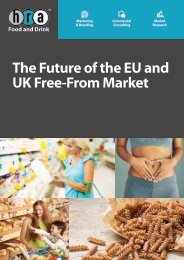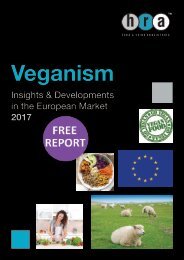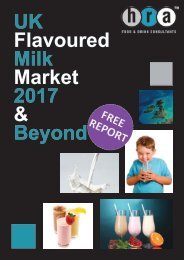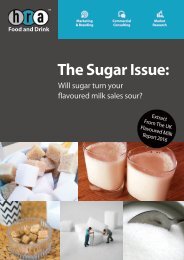FREE-UK-Flavoured-Milk-Report-2016-2017
The backdrop to the UK flavoured milk market is one of relentless change. The removal of the EU milk quotas, the transition to a Western-type diet by emerging economies, the UK sugar debate and the booming sports nutrition industry are all aspects of change that create both challenges and opportunities for the UK flavoured milk market. HRA Food and Drink Marketing has developed this report as a map to guide industry stakeholders. Although volume growth in 2014 was slightly lower than in previous years, the flavoured milk market still has plenty of room for product innovation and development. Overall, we expect the UK flavoured milk market to continue to grow over the medium term, but not without improving its nutritional profile. The sugar debate reached new heights when, in October 2015, Public Health England released a document suggesting Government intervention in the form of a sugar tax (levy). As a consequence, product reformulation has become a priority for all serious players in the market.
The backdrop to the UK flavoured milk market is one of relentless change. The removal of the EU milk quotas, the transition to a Western-type diet by emerging economies, the UK sugar debate and the booming sports nutrition industry are all aspects of change that create both challenges and
opportunities for the UK flavoured milk market.
HRA Food and Drink Marketing has developed this report as a map to guide industry stakeholders. Although volume growth in 2014 was slightly lower than in previous years, the flavoured milk market still has plenty of room for product innovation and development.
Overall, we expect the UK flavoured milk market to continue to grow over the medium term, but not without improving its nutritional profile. The sugar debate reached new heights when, in October 2015, Public Health England released a document suggesting Government intervention in the form of a sugar tax (levy). As a consequence, product reformulation has become a priority for all serious players in the market.
Create successful ePaper yourself
Turn your PDF publications into a flip-book with our unique Google optimized e-Paper software.
<strong>UK</strong>#FLAVOURED#MILK#<strong>2016</strong>217#<br />
#<br />
Figure 6-10: Adults over 65 years of<br />
age<br />
•# The age group that consumes the most sugar is teenagers (11 to 18<br />
years of age).<br />
•# In this category, teenage boys generally consume significantly more<br />
than teenage girls. This difference is also reflected in adults where<br />
men consume more sugar than women.<br />
c)! Sources of NMES according to age group, National Diet and Nutrition<br />
Survey, rolling programme 2008-2012<br />
•#<br />
•#<br />
•#<br />
The age group that consumes the most sugar derived from milk<br />
products (including flavoured milk) is children between the ages of 1 to<br />
3 with 19% of sugar from this source.<br />
The second group that consumes the most sugar from these products<br />
is children between the ages of 4 to 10 where 14% of sugar comes<br />
from dairy sources.<br />
The group that consumes the least amount of sugar from milk<br />
products is adults with 8% of NMES coming from milk products.<br />
#<br />
© <strong>2016</strong> Teepee Limited. All Rights Reserved.<br />
149







